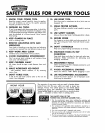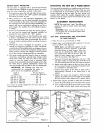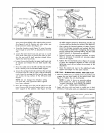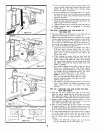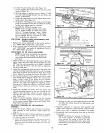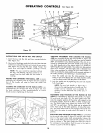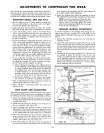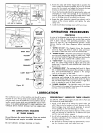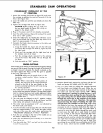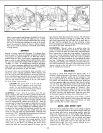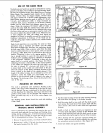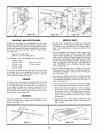
Figure 15
Figure 16
Figure 17
• I
FENCE,,,,,.,, BLADE TRAVEL BLADE TRAVEL //FENCE
BLADE.E EL,.O --ti VIEW Bill MARr._LADE,NHEEL,NGBOARD
To C[FT Figure 18 TO RIOHT
II
f.
g.
STEP
1.
2.
c. If the saw blade moves away from the square as it
comes forward, loosen the front arm latch screw and
tighten the rear arm latch screw. Recheck blade
travel and repeat if necessary.
d. If the saw blade moves toward the square as it comes
forward, loosen the rear arm latch screw and tighten
the front arm latch screw. Recheck blade travel and
repeat if necessary.
e. When the adjustment is correct, both arm latch screws
should be snug against the arm latch handle but not
tight enough to bind the handle.
Tighten the set-screws to secure the arm latch screws.
Adjust indicator scale, as described in preceding
paragraph 6.
FIVE--SQUARING THE SAW BLADE TO
THE TABLE TOP
Place the edge of a framing square on the table top and
against the saw blade as shown in figure 15.
When the saw blade issquare to the table top, no light
will be visible between the square and face of saw blade.
Do not allow the square to rest against a tooth of the
saw. If light is visible between the square and face of
saw blade (with square leg held firm against the table
top), perform the following adjustments:
a. Loosenthe bevel lock knob just slightly and, with a
5/16-inch Hex-L wrench, loosen the two socket-
head screws that secure the handle to the yoke. (See
figure 16.) A screw is located at each side of the
swivel index knob.
b. While holding the motor with one hand and the
square with the other hand, tilt the motor until saw
blade is square with table top. Then, while holding
the square firmly against the saw blade and table
top, tighten the bevel lock knob to hold motor and
blade in position.
c. Move handle slightly toward left or right until swivel
index pin is properly seated. Push firmly against
swivel index knob (keeping swivel index pin seated)
and tighten the two socket-head screws. The swivel
index pin should slide freely in the handle.
NOTE: It may be necessary to perform more
than one trial operation before the saw blade
remains perfectly square with table top after
tightening the screws.
d. The indicators (pointers) should read 0° on the bevel
scale. If not, loosen the indicator attaching screws,
adjust indicators to zero and tighten the screws
securely.
STEP SIX--CHECKING THE SAW BLADE FOR HEEL
(LEFT AND RIGHT)
1. Place the rip fence against rear edge of front table,
place the spacer against the rip fence, then place rear
table against the spacer. (See figure 20.) Slide all three
items into position so that ends are even with front table.
2. Engage a table clamp in the exposed "'keyhole" in each
table support and tighten the two clamps to secure all
rear table components. (See figure 20.)
3. Place a square against the rip fence and the saw blade
as shown in figure 17. The long leg of the square must
be held firmly against the rip fence and the short leg
must not touch any of the teeth on the saw blade.
4. If a gap exists between the saw blade and the square,
one of two types of heel exists. The two types of heel
are illustrated in views "A" and "B", figure 18. To cor-
rect for either type of heel condition, proceed as
follows:
a. Remove the left-hand carriage cover by removing
the two attaching screws. (See figure 17.)
8




